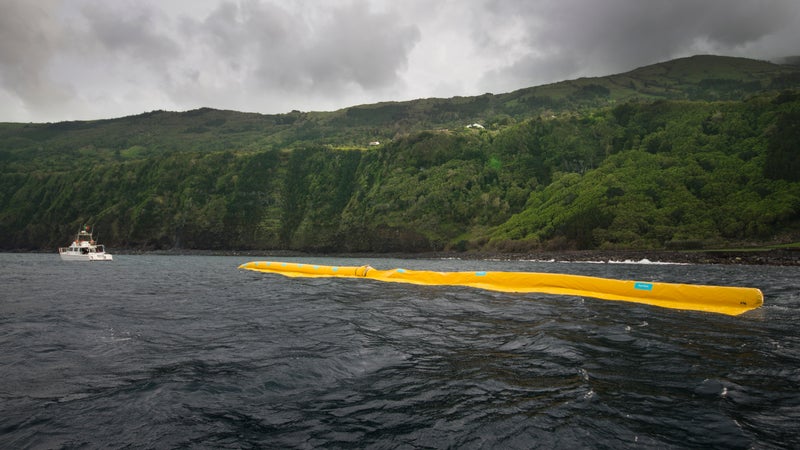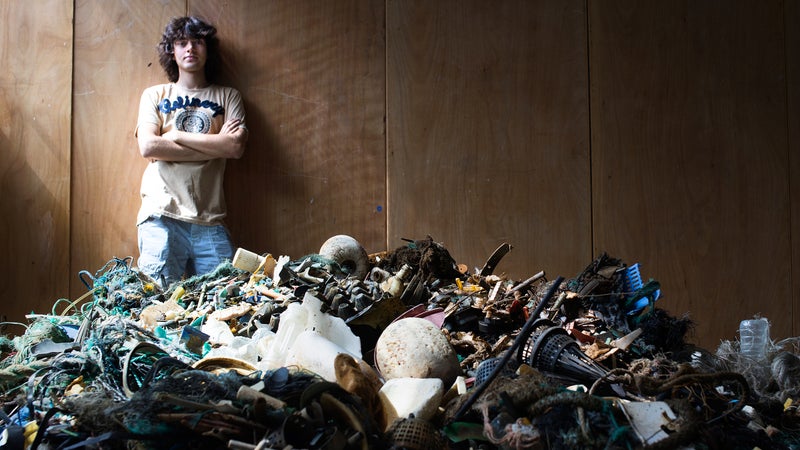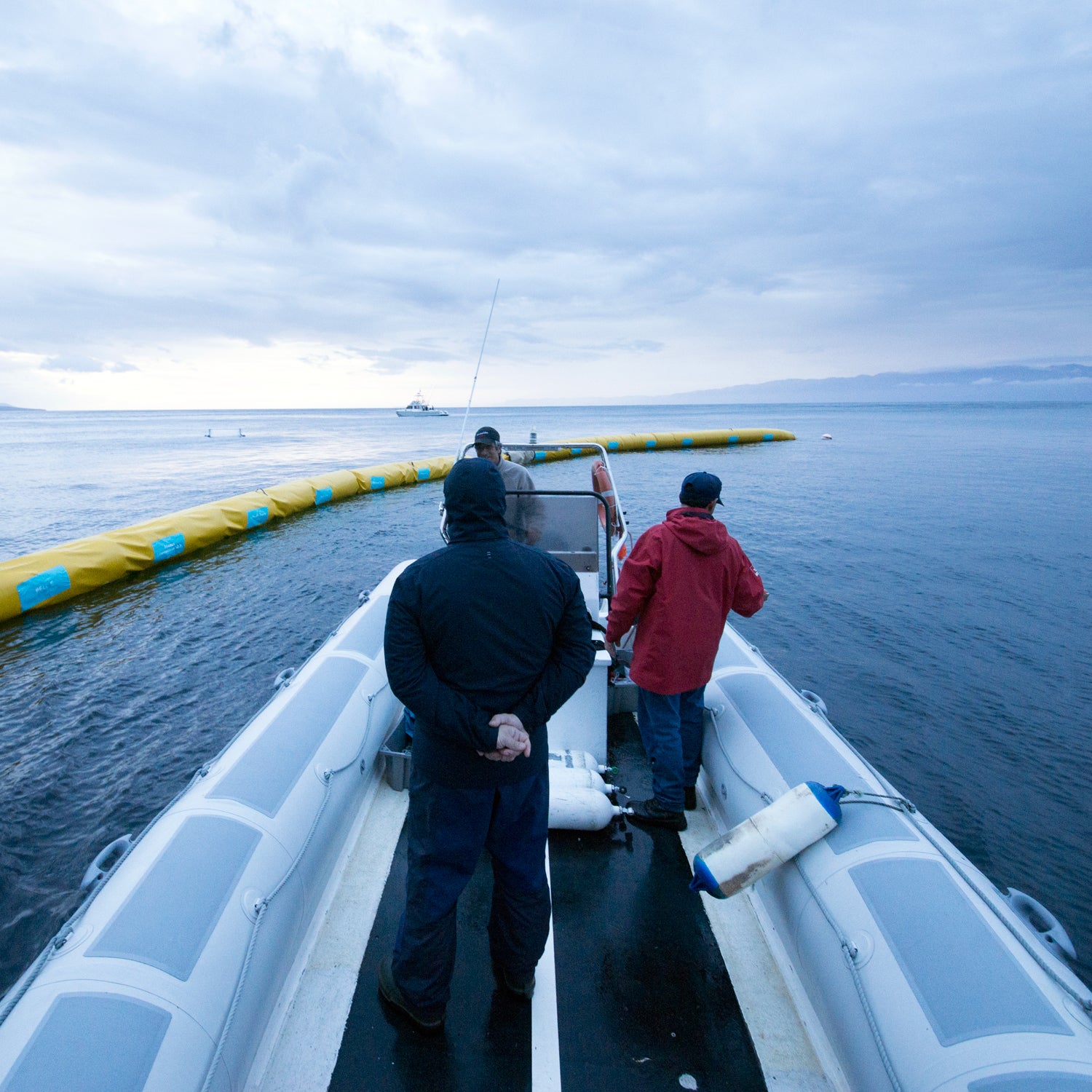Dutch engineering student Boyan Slat shocked the environmental community when he announced in a that he had invented a way for the oceans to rid themselves of plastic with minimal human intervention.
After all, we’re funneling a jaw-dropping 8 million tons of the stuff into the oceans each year, in addition to the more than five trillion pieces of plastic garbage already swirling in the waters. Could a then-17-year-old really have found a simple solution to this massive problem?
Many environmentalists didn’t think so, but Slat’s idea was nonetheless intriguing. He proposed building a stationary array with floating barriers that would filter and collect floating plastic using the ocean’s natural currents.

The theory: Use currents to have pollution come to you, rather than chase the garbage around the ocean—a costly and resource-intensive endeavor. But the research wasn’t thorough enough to convince the scientists the ocean array would succeed. They worried that inserting such an intrusive structure would have too many potential unintended consequences, including interfering with wildlife, to undertake the project. Good thought, they said, but try again.
So he did. Fast-forward three years, and Slat, 20, now has a and $2.1 million in crowdsourced funding backing his pilot project. The plan is to deploy a 6,561-foot prototype array designed to collect plastic off the coast of Japan in 2016. If all goes as planned, he’ll send off a production vessel measuring 62 miles long in 2020 that he says could remove 42 percent of the Great Pacific Garbage Patch within ten years.
Here’s how the tech works: The V-shaped ocean array will be made of 62 miles of floating barriers that drop, skirt-like, almost ten feet below the surface. (The Ocean Cleanup’s measurements have shown that the concentration of garbage decreases deeper than that.)
The array won’t move. Instead, it’ll be anchored to the seabed (12,795 feet below the surface) between Hawaii and California in the North Pacific Gyre—one of five major oceanic areas where currents converge—collecting plastic and trapping the pollution at the surface while allowing marine life and plankton to continue flowing with the current under the barrier.

The team predicts that 80 percent of the plastic that hits the booms, up to 2,295 cubic feet per day, will be corralled, spun through a centrifuge, and transferred to a collection platform via a solar-powered machine. Every 45 days, boats will collect the plastic and transport it to shore. There, the plastic can be recycled or converted to oil. Estimates say the Ocean Cleanup will be 33 times cheaper and 7,900 times faster than conventional net-and-trawl proposals.
“Considering the fact that what we plan to do has never been done before,” Slat says, “it is likely we’ll come across operational challenges which will require tweaking the system. However, the basic principles—the capturing and concentrating of plastic powered by natural currents—have been extensively studied using both simulations and proof-of-concept tests.”

Nevertheless, experts aren’t convinced. Their main concerns:
There’s no environmental impact statement.
The Ocean Cleanup isn’t holding itself to the same accountability standards as other large-scale engineering and mining operations in the ocean, partially because legalities are a gray area in international waters.
The device will miss the majority of plastic pollutants.
The booms are designed to trap floating pieces larger than two centimeters. But a majority of the ocean’s plastic, experts say, is in the form of degraded toxins much smaller than that. “Most of the plastic isn’t even at the surface waters that the array will be in,” says deep-sea ecologist and marine conservationist Andrew Thaler. “Now it becomes a question of what impact is this really going to have?”
The potential effects on ocean life and ecosystems could be disastrous.
Floating structures in the ocean tend to act as fish aggregators, Thaler says, regardless of whether the species get trapped. This means the array, near which both fish and plastics will pool, could disrupt migration patterns, expose large populations of fish to more concentrated plastics, and have rippling effects on the marine life that ingests it.
The team hasn’t done enough research.
Going from concept to pilot technology of this scale in three years is very rushed, says Jenna Jambeck, associate professor of environmental engineering at the University of Georgia and co-author of the article “Plastic Waste Inputs from Land into the Ocean” (Science, February 2015). “If it hasn’t been holistically and systematically integrated, we don’t know if it should happen,” Jambeck says. “We don’t even know enough about the ocean—that’s 70 percent of our planet—to know what the impact will be.”
Other experts agree: “It’s a project put together by engineers,” Thaler says. “They see a problem—a lot of plastic in the ocean—and they figure out a solution for that. But they haven’t necessarily taken into account other related issues.”
Oceanographer Kim Martini and marine biologist Miriam Goldstein, who completed a detailed of the feasibility report for ocean news outlet Deep Sea News, feel that Slat and his team have not adequately addressed their concerns. They sum it up like this: “We continue to have serious reservations about the success of the project due to … the Ocean Cleanup’s substantive misinterpretation of oceanography, ecology, engineering, and marine debris distribution, all of which are necessary for this project to succeed.”
Prevention is far more critical than extraction.
Many environmentalists say the resources and funding funneling into the Ocean Cleanup are deflecting attention away from the real need: making sure plastic doesn’t enter the ocean in the first place. Even if the equipment works flawlessly, will it matter in five years when the ocean is full of trash again? Thaler says it’s a societal state of mind: “We like technocratic solutions—a piece of problem solving we can drop somewhere that doesn’t require us to change our behavior.”
Slat responded to many specific criticisms in , but perhaps the biggest takeaway from the Ocean Cleanup philosophy is this: “It is not a question of either cleanup or prevention,” Slat says. “It’s cleanup and prevention. If a cleanup started today, it would be a bit like mopping up the floor while the tap is still running. Prevention is absolutely essential. But until now, the mop hadn’t been invented yet. The plastic trash that’s out there won’t go away by itself.”


